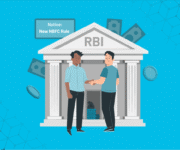With the potential to disrupt the traditional lending landscape, OCEN is an ocean of possibilities. OCEN is what we would call – financial inclusion in an absolute sense. It aims to render the objective of delivering credit to small businesses.
MSMEs of India are credit deprived, which poses a challenge for the growth-led economy we envision. On the other hand, this sector fuels the growth of our economy with potent ideas and 29% of India’s GDP.
However, given RBI’s efforts to change the face of the lending ecosystem, MSMEs in India are still in the shadows of financial inclusion. As per reports, MSMEs suffer a credit gap of Rs 20-25 trillion, with addressable credit demand of Rs 37 trillion and an existing mainstream supply of Rs 14.5 trillion.
Let us see how OCEN promises to overturn India’s credit depravity.
Is OCEN the Next Digital Public Good?
Yes, there are expectations OCEN is the next big public good in the lending landscape, but not in a literal sense. First things first: OCEN is not a product or a service. It is a protocol infrastructure of APIs for transactions between a lending firm and lenders.
OCEN, aka Open Credit Enablement Network, was introduced at the Global Fintech Festival 2020. But, for the idea to bloom into a success, a bar of effective implementation is required.
Digital lending platforms can now create their bespoke products in line with the standards of OCEN. In addition, it lays down the standard language for collaboration and partnerships between both parties.
Through OCEN, lender firms can underwrite norms with access to fresh data and information. In addition, OCEN sets some new standards of monitoring credit downright.
It all started with IndiaStack, the set of open APIs. IndiaStack lays down the open specification as the digital infrastructure driver for governments, businesses, startups, and developers.
IndiaStack kickstarted with the release of UIDAI. Some of the open APIs it offers are UPI, BharatPay, BBPS, Aadhar, AEPS, eKYC, eSign, DigiLocker, FASTag, and the GSTN platform. The next ultimate addition to IndiaStack is OCEN.
OCEN is set to change the regular lending norms by leveraging digital infrastructures. In addition, it would change how credit is disbursed by introducing new lending standards. All such standards will build a reliable, convenient, paperless, and inclusive credit ecosystem.
OCEN is the Growth Stack for Small Businesses
Big companies get to play their cards right with access to credit. MSMEs, on the other hand, though deserving, are left in a hunch of credit approvals. So OCEN builds a standard screening process of lending between lenders and digital platforms.
Loan service providers would not have to massively invest in technology development to include a credit product into their pipeline. Instead, OCEN’s open API standards would do the job.
Better yet, loan service providers themselves would be able to become leaders shortly. It would be possible to do business at low-cost customer acquisition and streamlined payments.
Also, soon, small business owners selling through eCommerce platforms can avail of a daily credit settlement. This means they would be able to borrow along the day and possibly pay it by EOD.
The loan disbursal process for such credit options would depend upon cash flow instead of income and assets. In addition, borrowers would have multiple lending platforms to choose from, and the entire process would be digital.
There is more: the simple and automated process will bring down turnaround time and application costs. However, merchants need to set up a mandatory payment process through UPI’s autopay feature. A win for the small business owners indeed.
Solutions that OCEN Offers
Let us walk through the problems and concerns that OCEN addresses:
- It identifies borrowers worthy of credit
- OCEN brings down the cost of borrower acquisitions which is increasingly problematic for the lending firms.
- The technology part aims to automate the manual process of integration that cuts time and costs.
- The time interval of actually disbursing the loan into the borrowers’ account is cut too.
- Fintech firms that aim to launch a bespoke credit product into the pipeline will now find it easier to do so.
- Any MSME deprived of legal credit access will have a gateway to credit.
- Firms can establish a self-sufficient chain of lending. This could include underwriting, disbursement, capital arrangement, dispute management, payment, recollection, and more.
Here are the Gaps that OCEN Aims to Fill
With the solutions that OCEN offers, here is what would change if it does get implemented:
Open credit access
This means OCEN would be more accessible for new players to enter the credit market by offering unique products. Firms would have better access to credit data which would help them create unique offerings.
With OCEN, any digital platform can position itself as delivery of credit. Likewise, technology partners can offer their unique tech solutions to fill the gaps in OCEN. This would help create a safe space for transactions between a lending service provider and a lender.
Financial inclusion
The credit flow typically breaks down for MSME as a lender. The reason for the breakdown is no formal data to facilitate underwriting MSME. This is how spotting a worthy borrower gets expensive for a traditional lending source. Also, the loan requirements of such MSMEs are different compared to established organisations.
OCEN barges past this significant issue by creating a new way of doing things. Lending firms can use open data for underwriting needs and quickly disburse the loan amount.
OCEN aims to make the process automated, instant, paperless, and solution-oriented. This would open the doors of credit for small-scale borrowers—the credit-deprived section of the society.
Innovative products
There is no denying, with the open protocols in place, we would see some ground-breaking credit products in the market. In addition, we would see new players who are well informed of the market’s shortcomings and a likewise solution.
We would see some major tailored credit products in action that would fit the diverse credit needs of borrowers. The terms and conditions of the transaction would also be drawn in favour of both parties.
Implementing OCEN may not accelerate as fast as UPI since a lot of frameworks and parties need to be jolted down. But, when implemented, OCEN would ultimately disrupt how we view credit disbursement in India. It would be a game-changer for the MSMEs especially, and ultimately our economy.
Keep an eye on Finezza’s blog for more insightful stories on what is happening in India’s leading landscape.




Leave a Reply